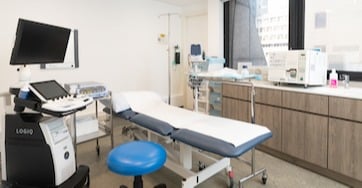October is synonymous with Breast Cancer Awareness. According to the American Cancer Society, It affects 1 in 8 women [1]. In 2020, CHP reported that breast cancer was the commonest cancer among females in Hong Kong accounting for “28.4% of all new cancers in females diagnosed in Hong Kong”[2].
Thanks to good screening practices and the advancement of medical treatments, there is now a strong chance of surviving breast cancer. However, it's still responsible for 12.2% of all cancer deaths in females making it incredibly important to recognise the signs and symptoms or attend regular screenings.
What is Breast Cancer?
Breast cancer is a type of cancer that develops in the mammary gland tissue in the breast. It is common in women, but men can also get breast cancer. Most often, breast cancer is discovered by a lump in the breast.
What Are The Risk Factors for Breast Cancer?
According to the Centre of Health Protection, it is recommended for women to start screening for breast cancer in Hong Kong regularly at age 35[3]. Certain risk factors can increase the possibility of breast cancer according to the University of Hong Kong[4]:
- Women aged 44 – 69 years old
- Have a family history of breast cancer
- High body mass index
- Low physical activity
Your doctor might advise annual or biannual breast screenings for people at moderate risk for breast cancer.
How Can You Recognise the First Sign of Breast Cancer
Many people know that an abnormal lump in your breast can indicate breast cancer. But other symptoms are less well known. You must know your breasts well (how they feel and look) so that you can notice a change in time with which you can detect an abnormality. If you are worried about any abnormality in your breast or nipple, then go to your doctor. It is also wise to get a breast examination or screening from your doctor every year to ensure you are not missing anything.
Symptoms of Breast Cancer
A breast lump is one of the most common symptoms of breast cancer. There are also other symptoms or changes that may indicate breast cancer. Common symptoms of breast cancer include:
- New lump or area of thickened tissue that was not there before
- Change in the size or shape of one or both breasts
- Discharge from nipples
- Lump or swelling in armpits
- Dimpling on the breast skin
- Rash on or around your nipple
- Change in the appearance of your nipples
Note: Breast pain is not usually a symptom of breast cancer.
You should see your doctor if you experience any of the symptoms above.
To spot any suspicious changes, it's important to check your breasts regularly so you will be able to recognise any abnormalities earlier.
Understanding the Different Stages of Breast Cancer
Breast cancer is classified into stages based on the tumour's size, whether it has spread to lymph nodes, and if it has metastasised to other parts of the body. Understanding these stages is essential for determining the most appropriate treatment options.
Stage 0 Breast Cancer: Non-invasive (In-situ) Cancer
Stage 0 breast cancer is also known as the “in-situ stage”, where the tumour/cancerous cells are limited within the confines of the duct and have not invaded the adjacent space/tissues. Because of their non-invasiveness, these tumours are considered precursors to invasive cancers and point to higher susceptibility to developing invasive cancer later on. Most of these cases are detected on screening mammography and are later confirmed via needle or core biopsies. The prognosis is excellent, with normal life expectancy for most who undergo treatment.
Stage 1 Breast Cancer: Early Detection and Localised Growth
Stage 1 breast cancer is the earliest and most treatable form of invasive disease. At this stage, the tumour is small (up to 2 cm in diameter) and remains confined to the breast tissue. It may also involve a small number of cancer cells in a nearby lymph node but has not spread further. Treatment typically includes surgery, often followed by radiation therapy and sometimes hormone therapy or chemotherapy. Early detection at this stage significantly improves the chances of a full recovery and long-term survival.
Stage 2 Breast Cancer: Larger Tumors or Limited Spread
Stage 2 breast cancer indicates a larger tumour (2-5 cm) or a smaller tumour that has spread to a few nearby lymph nodes. It is still considered an early stage but may require more extensive treatment than Stage 1. Treatment options often include surgery (either lumpectomy or mastectomy), radiation, chemotherapy, and possibly targeted therapy or hormone therapy, depending on the cancer's specific characteristics. The prognosis at this stage is still generally favourable, especially with prompt and comprehensive treatment.
Stage 3 Breast Cancer: Advanced Local Spread
Stage 3 breast cancer is more advanced, characterised by a tumour that is more than 5 cm or extensive spread to multiple nearby lymph nodes, including those near the collarbone or chest wall. It may also involve the skin or chest wall, causing symptoms such as swelling, skin changes, or ulceration. Treatment at this stage often requires a combination of surgery, chemotherapy, radiation, and targeted therapy to manage the local spread and reduce the risk of further metastasis. Although it is a more severe diagnosis, aggressive treatment can still be effective.
Stage 4 Breast Cancer: Metastatic Spread
Stage 4 breast cancer, also known as metastatic breast cancer, means the cancer has spread beyond the breast and nearby lymph nodes to other parts of the body, such as the bones, liver, lungs, or brain. It is the most advanced stage, and while it is not curable, treatments aim to control the spread of cancer, manage symptoms, and improve quality of life. Treatment options may include systemic therapies such as chemotherapy, hormone therapy, targeted therapy, or immunotherapy tailored to the patient's specific condition and the location of metastases. Regular monitoring and supportive care are crucial for managing the disease effectively. The Oncotype DX test can help predict whether breast cancer is likely to recur, assisting doctors in planning post-treatment care.
What Is Included In a Breast Screening?
Breast screening will normally include a breast examination from a Family Doctor (GP) or Gynaecologist (OBGYN), a mammogram and sometimes an ultrasound. A mammogram is a non-invasive, specialised medical imaging that uses a low-dose x-ray system to see inside the breasts. During a mammogram, the breasts are gently flattened between two plates of the x-ray machine to spread the breast tissue apart gently. Breast images are then taken to check for abnormalities.
Combined with ultrasound, this is considered the most appropriate way to screen for early signs of breast cancer.
Having regular screenings means catching breast cancer early and lowering the risk of dying from it. Regular mammographic screening and catching breast cancer early is associated with an approximately 20% reduction in breast cancer mortality[5]. If in doubt, make sure to consult your doctor or gynaecologist for advice.
Reference
1. Breast cancer facts and statistics. (n.d.). Retrieved September 22, 2022, from https://www.breastcancer.org/facts-statistics
2. Centre for Health Protection, Department of Health - Breast Cancer. Centre for Health Protection. (n.d.). Retrieved September 22, 2022, from https://www.chp.gov.hk/en/healthtopics/content/25/53.html
3. Centre for Health Protection, Department of Health - Breast Cancer. Centre for Health Protection. (n.d.). Retrieved September 22, 2022, from https://www.chp.gov.hk/en/healthtopics/content/25/53.html
4. Update on the Recommendations on Breast Cancer Screening by the Cancer Expert Working Group on Cancer Prevention and Screening. HKMJ. (2022, April 26). Retrieved September 22, 2022, from https://www.hkmj.org/abstracts/v28n2/161.htm
5. Marmot, M. G., Altman, D. G., Cameron, D. A., Dewar, J. A., Thompson, S. G., & Wilcox, M. (2013, June 6). The benefits and harms of breast cancer screening: an independent review. Nature News. Retrieved September 22, 2022, from https://www.nature.com/articles/bjc2013177
6. Hospital Authority. Overview of Hong Kong Cancer Statistics of 2020. (8 September 2023) Retrieved from https://www3.ha.org.hk/cancereg/pdf/overview/Overview%20of%20HK%20Cancer%20Stat%202020.pdf
 Central General Practice
Central General Practice
 Repulse Bay
Repulse Bay
 Clearwater Bay
Clearwater Bay
 BodyWorX Clinic
BodyWorX Clinic
 Central Specialist Clinic
Central Specialist Clinic
 MindWorX Clinic
MindWorX Clinic
 Partner Clinics
Partner Clinics
 Family Clinic
Family Clinic
 OT&P Annerley Midwives Clinic
OT&P Annerley Midwives Clinic






-1.png?length=500&name=%5BMKT%5DWebsite%20Blog%20Photo%20(16)-1.png)
